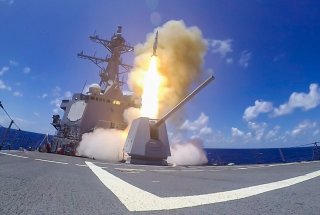China's 'Aircraft-Carrier Killer' Missiles: The Inconvenient Facts
They can sink far more than U.S. aircraft carriers, and only America seems to be in a position to stop them.
An old adage of defense analysis is that a weapon system that has not been tested does not, in any meaningful sense, exist. Testing gives an organization confidence that the weapon will function as intended, helps to work out technological bugs, and offers an opportunity to integrate a particular weapon into a broader system of technologies. If that’s the case, then China’s DF-21D and DF-26B “carrier killer” missiles now appear to exist.
On August 26, as part of a broader exercise that involved Chinese air and naval forces, the PLA tested one each of the DF-21D and DF-26B missiles. The DF-21D is a road-mobile medium-range ballistic missile with a range of some 1,500 km, while the DF-26 is a road-mobile IRBM with a range of up to 4,000 km, making it a threat against warships and bases operating deep in the Pacific. Both missiles have terminal maneuvering capabilities that enable them to target ships underway, leading some to dub them “carrier-killers” for the threat that they pose to the big aircraft carriers and amphibious assault ships of the United States, Japan, and Australia. As Tyler Rogoway notes, China has conducted some tests of its carrier-killer missiles before, but the integration of the launches into a larger set of naval and air activities suggests the development of doctrine and real operational capability.
The United States apparently observed the exercise via a U-2 overflight, to the extreme displeasure of the Chinese. Any such overflight of a live exercise would carry obvious risks, but the U-2 is designed for such missions and has conducted them since the early days of the Cold War. Of course, China could not hope to keep such testing secret, and indeed a visible demonstration of the missiles is half the point. The test of the missiles serves two purposes; to increase the effectiveness of the weapons themselves, and to warn the United States and others about China’s military prowess, an impression undeniably confirmed by the irritable U.S. reaction.
The very existence of the missiles has produced a family of glib claims that the missiles have rendered the aircraft carrier obsolete. A ballistic missile capable of terminal maneuvering as it approaches an aircraft carrier undercuts the carrier’s primary defense, its mobility. But both of China’s missiles depend on an extensive set of sensors and communications nodes in order to find their target, maneuver towards them, and avoid any electronic or physical defenses that their victims can mount. This makes the integration of the weapons into a broader family of systems, including air, space, submarine, and surface, absolutely critical to their ability to have an impact. In case of war, the task of the U.S. military would be as much to blind the sensor’s that make China’s missiles lethal as to destroy the missiles themselves.
Nevertheless, concern over China’s ability to hold U.S. carriers at risk has led to calls for “distributed lethality” which would spread strike capability across a larger range of air, surface, and submarine platforms, as well as the abrogation of the Intermediate Nuclear Forces Treaty, which has allowed the United States to pursue the construction of its own medium and intermediate range cruise and ballistic missiles.
All of this comes as tensions between China and the United States have grown in the Western Pacific. The recent U.S. deployment of two carrier battle groups in July confirmed U.S. interest in making a show of force in the region, just as rhetoric over China’s domestic policies and ongoing territorial assertiveness in the East and South China Seas has sharpened. In the looming U.S. presidential election, tensions with China have become a talking point on both sides, with President Donald Trump taking credit for aggressive military, diplomatic, and trade stances, and Vice President Joe Biden arguing for persuasive regional diplomacy to counter the Chinese threat.
However, the potential of China’s missiles extends beyond the U.S.-Chinese relationship. Any missile that can hit a U.S. carrier can also hit one of Japan’s new aircraft carriers, or one of Australia’s new amphibious assault ships. Apart from the United States, no country in the region can hope to disrupt China’s system of anti-access systems, making the missiles a potential tool of regional military dominance. On the other hand, Japan seems increasingly willing to contemplate the development of its own offensive missiles, which would hold China’s ships and shorebound installations under similar risk.
Clearly, the United States has been aware of these missiles for a good long time. It seems that China is increasingly willing to demonstrate its full military capabilities both to Washington, and to the Western Pacific region. Whether this will result in increased tension or in a de-escalation remains to be seen.
Robert Farley, a frequent contributor to the National Interest, is author of The Battleship Book. He serves as a Senior Lecturer at the Patterson School of Diplomacy and International Commerce at the University of Kentucky. His work includes military doctrine, national security, and maritime affairs. He blogs at Lawyers, Guns and Money and Information Dissemination and the Diplomat.
Image: Flickr.

